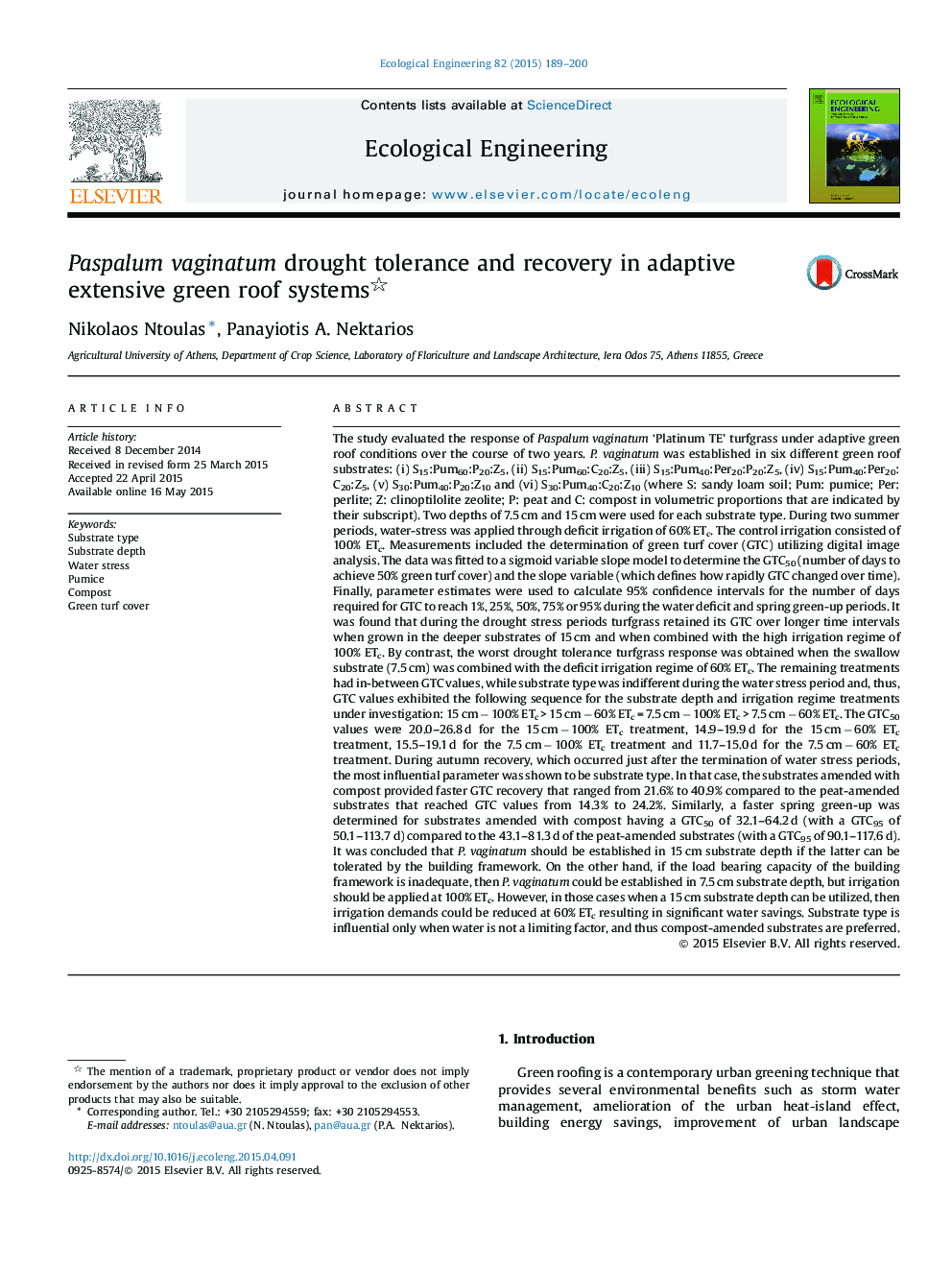| کد مقاله | کد نشریه | سال انتشار | مقاله انگلیسی | نسخه تمام متن |
|---|---|---|---|---|
| 4388963 | 1618017 | 2015 | 12 صفحه PDF | دانلود رایگان |
• Paspalum vaginatum growth was better at 15 cm substrate depth and the higher irrigation regime (100% ETc).
• During the water deficit periods, treatments revealed differences as much as 10–15 days in reaching 50% green turf cover.
• If substrate depth is reduced to 7.5 cm, water applications should increase to 100% ETc to retain adequate turfgrass growth.
• Under deficit irrigation, all substrate types behave in a similar manner.
• During the autumn recovery and spring green-up periods, compost-amended substrates significantly improved P. vaginatum green coverage.
The study evaluated the response of Paspalum vaginatum ‘Platinum TE’ turfgrass under adaptive green roof conditions over the course of two years. P. vaginatum was established in six different green roof substrates: (i) S15:Pum60:P20:Z5, (ii) S15:Pum60:C20:Z5, (iii) S15:Pum40:Per20:P20:Z5, (iv) S15:Pum40:Per20:C20:Z5, (v) S30:Pum40:P20:Z10 and (vi) S30:Pum40:C20:Z10 (where S: sandy loam soil; Pum: pumice; Per: perlite; Z: clinoptilolite zeolite; P: peat and C: compost in volumetric proportions that are indicated by their subscript). Two depths of 7.5 cm and 15 cm were used for each substrate type. During two summer periods, water-stress was applied through deficit irrigation of 60% ETc. The control irrigation consisted of 100% ETc. Measurements included the determination of green turf cover (GTC) utilizing digital image analysis. The data was fitted to a sigmoid variable slope model to determine the GTC50 (number of days to achieve 50% green turf cover) and the slope variable (which defines how rapidly GTC changed over time). Finally, parameter estimates were used to calculate 95% confidence intervals for the number of days required for GTC to reach 1%, 25%, 50%, 75% or 95% during the water deficit and spring green-up periods. It was found that during the drought stress periods turfgrass retained its GTC over longer time intervals when grown in the deeper substrates of 15 cm and when combined with the high irrigation regime of 100% ETc. By contrast, the worst drought tolerance turfgrass response was obtained when the swallow substrate (7.5 cm) was combined with the deficit irrigation regime of 60% ETc. The remaining treatments had in-between GTC values, while substrate type was indifferent during the water stress period and, thus, GTC values exhibited the following sequence for the substrate depth and irrigation regime treatments under investigation: 15 cm − 100% ETc > 15 cm − 60% ETc = 7.5 cm − 100% ETc > 7.5 cm − 60% ETc. The GTC50 values were 20.0–26.8 d for the 15 cm − 100% ETc treatment, 14.9–19.9 d for the 15 cm − 60% ETc treatment, 15.5–19.1 d for the 7.5 cm − 100% ETc treatment and 11.7–15.0 d for the 7.5 cm − 60% ETc treatment. During autumn recovery, which occurred just after the termination of water stress periods, the most influential parameter was shown to be substrate type. In that case, the substrates amended with compost provided faster GTC recovery that ranged from 21.6% to 40.9% compared to the peat-amended substrates that reached GTC values from 14.3% to 24.2%. Similarly, a faster spring green-up was determined for substrates amended with compost having a GTC50 of 32.1–64.2 d (with a GTC95 of 50.1–113.7 d) compared to the 43.1–81.3 d of the peat-amended substrates (with a GTC95 of 90.1–117.6 d). It was concluded that P. vaginatum should be established in 15 cm substrate depth if the latter can be tolerated by the building framework. On the other hand, if the load bearing capacity of the building framework is inadequate, then P. vaginatum could be established in 7.5 cm substrate depth, but irrigation should be applied at 100% ETc. However, in those cases when a 15 cm substrate depth can be utilized, then irrigation demands could be reduced at 60% ETc resulting in significant water savings. Substrate type is influential only when water is not a limiting factor, and thus compost-amended substrates are preferred.
Journal: Ecological Engineering - Volume 82, September 2015, Pages 189–200
